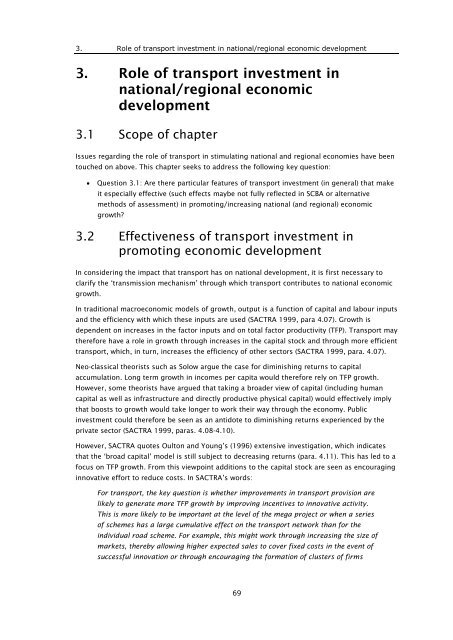Research 350 - NZ Transport Agency
Research 350 - NZ Transport Agency
Research 350 - NZ Transport Agency
You also want an ePaper? Increase the reach of your titles
YUMPU automatically turns print PDFs into web optimized ePapers that Google loves.
3. Role of transport investment in national/regional economic development<br />
3. Role of transport investment in<br />
national/regional economic<br />
development<br />
3.1 Scope of chapter<br />
Issues regarding the role of transport in stimulating national and regional economies have been<br />
touched on above. This chapter seeks to address the following key question:<br />
• Question 3.1: Are there particular features of transport investment (in general) that make<br />
it especially effective (such effects maybe not fully reflected in SCBA or alternative<br />
methods of assessment) in promoting/increasing national (and regional) economic<br />
growth?<br />
3.2 Effectiveness of transport investment in<br />
promoting economic development<br />
In considering the impact that transport has on national development, it is first necessary to<br />
clarify the ‘transmission mechanism’ through which transport contributes to national economic<br />
growth.<br />
In traditional macroeconomic models of growth, output is a function of capital and labour inputs<br />
and the efficiency with which these inputs are used (SACTRA 1999, para 4.07). Growth is<br />
dependent on increases in the factor inputs and on total factor productivity (TFP). <strong>Transport</strong> may<br />
therefore have a role in growth through increases in the capital stock and through more efficient<br />
transport, which, in turn, increases the efficiency of other sectors (SACTRA 1999, para. 4.07).<br />
Neo-classical theorists such as Solow argue the case for diminishing returns to capital<br />
accumulation. Long term growth in incomes per capita would therefore rely on TFP growth.<br />
However, some theorists have argued that taking a broader view of capital (including human<br />
capital as well as infrastructure and directly productive physical capital) would effectively imply<br />
that boosts to growth would take longer to work their way through the economy. Public<br />
investment could therefore be seen as an antidote to diminishing returns experienced by the<br />
private sector (SACTRA 1999, paras. 4.08-4.10).<br />
However, SACTRA quotes Oulton and Young’s (1996) extensive investigation, which indicates<br />
that the ‘broad capital’ model is still subject to decreasing returns (para. 4.11). This has led to a<br />
focus on TFP growth. From this viewpoint additions to the capital stock are seen as encouraging<br />
innovative effort to reduce costs. In SACTRA’s words:<br />
For transport, the key question is whether improvements in transport provision are<br />
likely to generate more TFP growth by improving incentives to innovative activity.<br />
This is more likely to be important at the level of the mega project or when a series<br />
of schemes has a large cumulative effect on the transport network than for the<br />
individual road scheme. For example, this might work through increasing the size of<br />
markets, thereby allowing higher expected sales to cover fixed costs in the event of<br />
successful innovation or through encouraging the formation of clusters of firms<br />
69
















